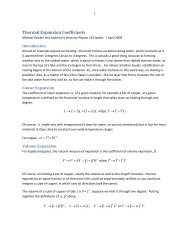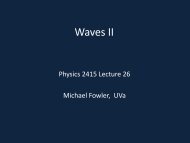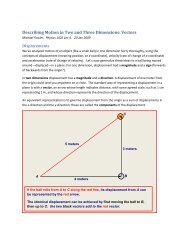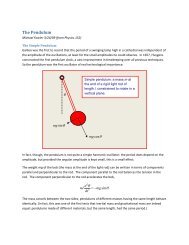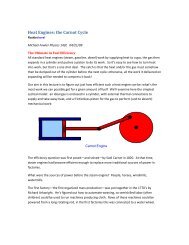5. Projectile Motion - Galileo and Einstein
5. Projectile Motion - Galileo and Einstein
5. Projectile Motion - Galileo and Einstein
- No tags were found...
You also want an ePaper? Increase the reach of your titles
YUMPU automatically turns print PDFs into web optimized ePapers that Google loves.
<strong>Projectile</strong>sPhysics 1425 Lecture 5Michael Fowler, UVa.
Reminder: <strong>Galileo</strong>’s Laws of <strong>Motion</strong>• Neglecting air resistance <strong>and</strong> friction, <strong>Galileo</strong>claimed:1. Horizontal motion: (ball rolling on table) anobject would continue to move at constantvelocity unless pushed.2. Vertical motion: a falling body wouldaccelerate downwards at a uniform rate.
<strong>Galileo</strong>’s Law for <strong>Projectile</strong>s• He asked himself: what would happen if theball rolled off the table?• He claimed (<strong>and</strong> established experimentally)that the balls uniform horizontal motionwould continue as before –• BUT natural vertical falling motion would beadded!• He termed the result “compound motion”.
Here’s <strong>Galileo</strong>’s own picture …<strong>and</strong> here’s a link to an animation.
Equation for the Trajectory• Taking t = 0 to be when the ball rolls off theedge, <strong>and</strong> the origin O at that point,xy== −v t0x12gt2from which( ) 0xy= − g v x2 2/2 .The st<strong>and</strong>ard parabola equation is y = ax 2 , sothis is half of an upside-down parabola.
Clicker Question• Suppose that as the ball rolling across thetable goes over the edge, it touches anotherball that was just balanced on the edge.Assume the first ball’s trajectory is notchanged, the second ball falls vertically down.A. The rolling ball hits the ground firstB. The dropping ball gets there firstC. They hit the ground at the same time
Car Goes Horizontally Over Cliff• Position at 1 secondintervals (v 0 = 20 m/s)• Velocities <strong>and</strong> Speedsat 1 second intervals:• g=0 trajectoryin red• Taking g = 10, positionsare (0, 0), (20, -5),(40, -20), (60, -45).• Speeds are approx:20, 22, 28, 36 m/s.
Full <strong>Projectile</strong> Path• A projectile is shot at some upward angle from theorigin: see animation.• <strong>Galileo</strong> tells us the horizontal motion is just steadyvelocity, the vertical motion is the same as that of aball thrown directly upwards.• Therefore1 2x = v t, y = v t − gt .0x0y2• Eliminating t gives a parabolic curve through O:( ) ( )0y 0x 0xy= v v x−g v x2 2/ /2 .
Vector Picture of <strong>Projectile</strong> <strong>Motion</strong>r=vt0 r = v t − gt10 22Position at 1 secondintervals (notice it fallsbelow straight line: theg =0 trajectory).Velocities <strong>and</strong> Speeds at1 second intervals.
Hang Time• How long does it take theball to go up <strong>and</strong> come backdown again?• Initial upward velocity v 0y ,upward velocity changes by–g each second, back downat –v 0y , so gt = 2v oy• Hang time:t=2v0yghttp://curlyr.blogspot.com/2008_09_01_archive.html
RangeA• Given the initial velocityv = v v( , )0 0x0yThe Paris gun, used by the Germanarmy to shell Paris in 1918. Its rangewas about 80 miles, 130 km.• The hang time is0 y<strong>and</strong> during that time the shelltravels a horizontal distance0x 0x 0y• This is the range.t = 2 v / gR= v t = 2 v v / g.http://en.wikipedia.org/wiki/File:Parisgun2.jpg
Maximum RangeA• Taking the muzzle velocity as fixed, howdo we vary the angle of firing θ tomaximize the range?• Now• Sov 0v = v cos θ,v = v0x0 0y0(2v ) 0g0x0y0(2)sinθR= 2 v v / g = 2 v / g sinθcosθ=/ sin 2θR v g= 2/max 0• And maximum range at 45°http://www.edupics.com/humancannon-t10746.jpgθv 0





